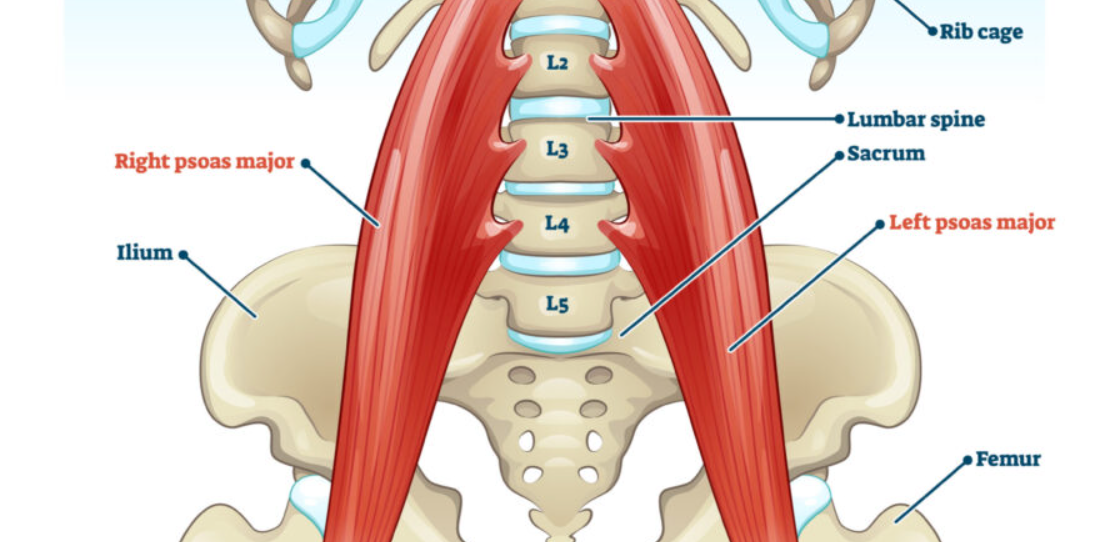The psoas muscle is one of the most crucial in our bodies.
Without this critical group of muscles, we won’t be able to get out of bed in the morning. However, it is also necessary for us to dance, run, practise yoga, or sleep on the sofa.
The psoas muscles connect our upper body and legs. These muscles have an impact on our posture and assist us maintain spinal stability.
These muscles consist of slow and fast twitching muscles. Because they are significant flexors, weakness may induce other muscles to compensate for them, resulting in overuse.
Tight psoas muscles may be the underlying cause of a variety of ailments, including pelvic and low back discomfort.
Excessive standing and twisting from the waist without moving the feet, as well as other actions that cause the leg to rotate externally while extended (ballet leg lifts, sit-ups, etc.), can strain these muscles.
Symptoms of Psoas Muscle Imbalance
- Pain in the knees and low back
If you have persistent knee or spine pain for no obvious reason, it could be related to psoas muscle tightness.
When the femur is locked into the hip socket due to a tight psoas, joint rotation is disrupted, resulting in knee and spine torque.
- Posture issues
When the psoas muscles are overly short or tight, the pelvis may tilt anteriorly.
This compresses the spine and contributes to what is known as duck buttocks. If the psoas is overly stretched and weak, the lumbar spine’s flatter natural slope may result in a flat buttocks.
- A discrepancy in leg length
When the psoas muscle is tight, the pelvis may rotate forward.
This adds to a leg rotation to the affected side. The opposite leg will spin externally in an attempt to counteract.
This lengthens the affected leg, causing every stride to force the leg up into the hip socket, resulting in leg discrepancy.
- Menstrual cramps
A psoas muscle imbalance may be partially responsible for severe menstrual cramps in women due to the additional pressure it places on the reproductive organs.
- Difficult bowel movements
When the psoas muscles are overly tight, it might lead to constipation.
This is because many lumbar nerves and blood vessels run through and near these muscles.
Tight psoas muscles may reduce blood flow and nerve impulses to the legs and pelvic organs.
The torso is also shorter, and the area for internal organs is reduced. As a result, food absorption and toxin elimination are not optimal.
5 Ways to Maintain the Health of the Psoas Muscle
- Introduce flexibility exercises
Resistance flexibility exercises work wonders on the fascia.
To strengthen the psoas, rest on your back with your hips against the wall. Lift one leg and place it straight against the well.
Bend one and extend the other. Slow down the action and use your hands to provide resistance.
Bring the bowed knee to the chest. Keep the elevated leg firmly against the wall. Repeat with the legs in different positions.
- Get a massage.
A professional massage can help relieve tension in the psoas muscles.
Assisted stretches and yoga can also help improve psoas balance.
- Manage stress and trauma.
If we don’t release stress effectively, it gets stored in our bodies.
Too much tension in the body might also be caused by unresolved prior traumas.
Daily stress relief options include nature walks, baths, meditation, yoga, exercise, social contacts, and so on.
- Try the constructive rest position
This position is ideal for reducing pelvic, hip, and low back stress while also keeping the body in a neutral position.
To do so, lie on your back. Bend the knees and place your feet on the floor, hip-width apart and parallel to one another. Separate the heels slightly from the buttocks.
Avoid pushing the spine into the floor or tucking the pelvis. Place the arms over the stomach. Repeat for 10 to 20 minutes daily to relieve stress and restore the health of the psoas muscles.
- Don’t sit for prolonged periods of time
If you have to spend long hours in a sitting position for business or other reasons, do so properly.
Keep the back straight and the hips slightly higher than the knees. Use a cushion to support your buttocks.
This will maintain the psoas muscles calm while lengthening the hamstrings. Always sit in chairs with back support, and try to rise up and walk around every hour or so.
After reading this text you can also read about: Remove Cracked Heels and Get Beautiful Feet Permanently: Magical Home Remedies with Red Onions



